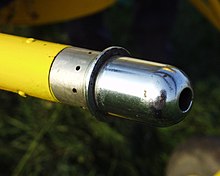Prandtl probe

The Prandtl probe (named after Ludwig Prandtl ), also called Prandtl's pitot tube , is a fluidic measuring instrument for determining the dynamic pressure . It is a combination of a pitot tube and a static pressure probe. The Prandtl tube has an opening against the direction of flow to measure the total pressure and a ring-shaped bore at a well-calculated distance from the tip and the shaft for static pressure measurement. According to Bernoulli's law, the difference between these two pressures corresponds to the dynamic pressure ( dynamic pressure ). The dynamic pressure can be determined directly by a manometer ; alternatively, the velocity of the air flowing around the probe can also be calculated using the dynamic pressure. This is important in aviation for determining airspeed (see True Airspeed ). The Prandtl probe is usually part of a pitot static system .
Determination of the air speed
A pipe system containing a liquid is used to determine the air speed. A force acts on this fluid , which is caused by the difference between static and dynamic pressure.
The Prandtl probe is placed in an air flow in such a way that the flow hits the front opening perpendicularly. The pressure at the stagnation point resulting from this arrangement is the sum of the static and dynamic pressure (also called dynamic pressure ). According to Bernoulli's equation :
Further openings of the probe are positioned in such a way that the air flows past them without building up. In the interior of the probe there is only static pressure and the following applies:
There is a pressure difference between the pressures inside and outside the Pitot tube , which only consists of the dynamic component of the pressure:
The physical implementation of the differential measurement is outlined in the schematic representation of the Pitot tube. A pipe serves as a connection between the stagnation point and the side openings. A liquid is introduced for the measurement. Correspondingly, there is a force of
where is the cross-sectional area of the tube. This force moves the column of liquid in the pipe. As soon as a height difference of is reached, the gravitational force counteracts the process: A mass of
causes a force of
There is an equilibrium of forces :
This equation can be used to determine the speed :
literature
- Helmut Eckelmann: Introduction to flow measurement technology. Teubner, Stuttgart 1997, ISBN 3519023792 .
Web links
- Measurement of volume and mass flow (accessed on July 4, 2019)
- Procedure for measuring the exhaust gas velocity of an internal combustion engine (accessed on July 4, 2019)
- TURBULENT HEAT TRANSPORT IN LIQUID LEAD WISMUTH ON A VERTICAL HEATING ROD IN THE RINGSPTALT (accessed on July 4, 2019)
- Experimental investigations on vortex dynamics at the stalling engine intake (accessed on July 4, 2019)
- Comparison of in vitro velocity measurements using hot wire anemometry with CFD simulations of a special basilar artery model (accessed on July 4, 2019)
















